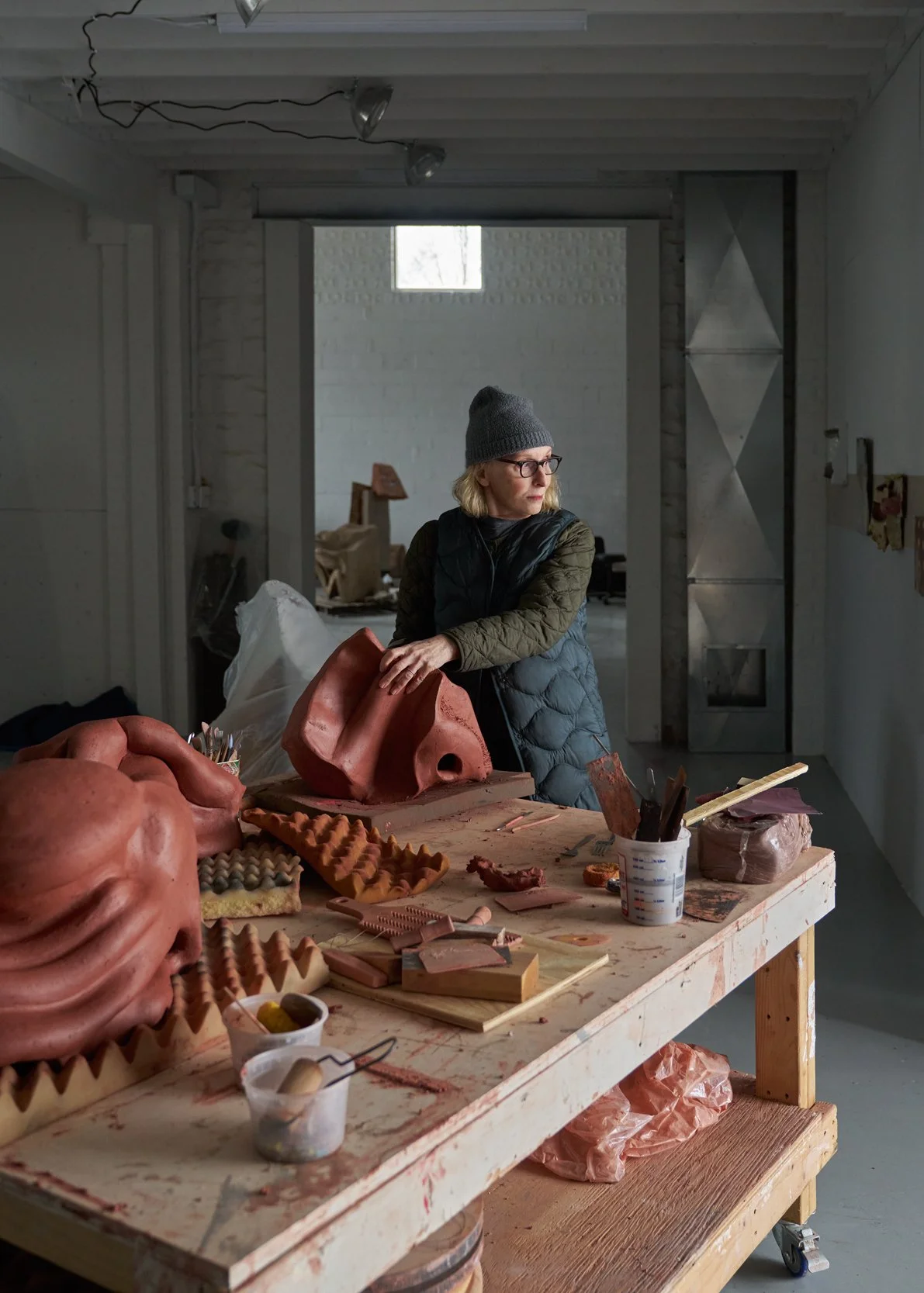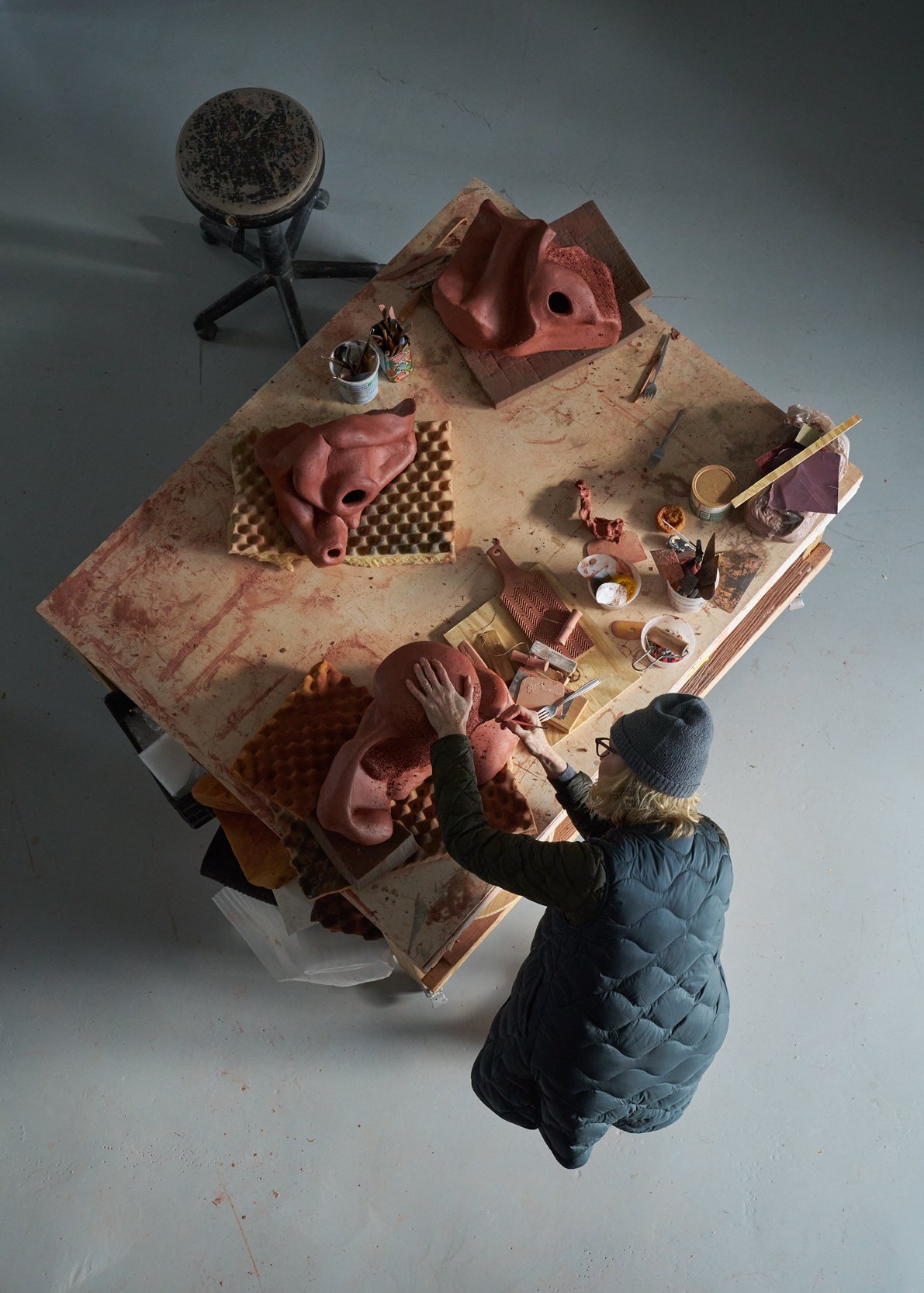Words Stephen Greco Photography Martien Mulder
Published in No 18
Work in progress.
Arlene Shechet at work with clay in her studio.
A lot of contemporary sculpture is said to embody motion — in dynamic forms, in lively surfaces, etc. And certainly, sculpture does induce us to move around it and absorb its truths by way of multiple views. Arlene Shechet’s sculpture, though, seems to evince another kind of motion, too. It occupies space with us in a deceptively stationary way, as if it were in motion in some higher dimension but can show itself to us here only in a tense state of giddy potential, ready to… what?
It's this exciting feeling of not knowing what might happen that helps give Shechet’s work such appealing power — and this may be what the late art critic Peter Schjeldahl meant when he described Shechet’s work as "intimately brawny." These objects want to clobber you and do so, though in a lovely and quite informative way. Fearlessly, often seductively, Shechet manages to combine forms, materials, colors, and textures that don’t simply surprise you on first view, but keep you in a breathless, steady state of surprise that verges on shock.
Often, the white box of a gallery space seems too puny to contain such power, which is why it’s so thrilling to contemplate the new installation of Shechet’s work that just opened at the Storm King Art Center’s vast pastoral site. On view there through November are six of the artist’s large-scale outdoor works, newly commissioned, along with a suite of complementary indoor pieces, all of steel, wood, and ceramics. Entitled Girl Group, the installation is an outgrowth of the ceramic-and-steel work Shechet was doing during COVID — smaller in scale than the work she had been doing previously, because her assistants couldn’t come to the studio, and exuberantly colorful because “what we needed was joy, and one of the things that gives me joy is color.”
Work in progress in the studio.
Arlene Shechet at work with clay in her studio.
SG So you produced these small-scale works, and then you had five-hundred acres of hills and fields to play with.
AS Wildly challenging! But I think that's why I wanted to do it. I was just here by myself and trying to figure out how a hunk of steel and a piece of ceramic could just balance. But then after a year I felt like this is telling me something and I don't know what it is, and I need to follow it. My general knowledge told me that I should get some of these works scanned and enlarged, and have a foundry make them big. And that's the way most large sculptures are done now. But for me, I felt I needed to learn something, and to translate rather than enlarge. I didn't want to make the same thing big.
And during the pandemic, I also had the opportunity to learn that I actually could be involved in drawing using digital tools and all kinds of technologies that could get me inside an artwork and let me play with it on a screen. And so, these [Storm King] works were born with me making the ceramics and then riffing on it digitally. But of course, I knew that the digital riffs would not be satisfying to me, nor would they be a complete story. So, then I went back to analog and built these things in paper or slapped them together to look at what I had conjured digitally; and then I kept doing that. So, it was very much analog, digital, analog, digital…
SG How many people normally work with you in your studio?
AS There are four of us. I keep it tight. I have no interest in making a factory of my studio, because making the work is the fun. I don't understand people not having that fun. One needs to have that fun in order for all of it to make sense, but I do need help. I make sculpture in real time, so I am like, here's a hunk of wood, I need to move that, strap it together … There are lots of procedures that I can't or don’t want to do by myself, and there's also now engineering skills that I realize I don't need. I understand all of it, but I don't need to do it.
SG How did you find yourself responding to the Storm King site — the actual landscape? Did you walk around and point and say “There, and there, and there…”? Or did you use ideas like “borrowed landscape,” as in Japanese gardens, or ignore ideas like that…?
AS The siting emerged over time. I’ve been thinking about it for at least a year and a half. Imagine me and the Storm King team and my studio team in golf carts, in every kind of weather, traveling the whole park. I decided that I would site several things in and around the beautiful museum building, but I also wanted to go farther afield. And so, things are wandering off. I also wanted the works to speak to one another. They are a girl group, so I wanted them to relate to one another.
Iron Twins, 2022, in Shechet’s studio courtyard.
One of the “studio wood piles.”
SG This helps me understand a little bit more about the title — this notion of the pieces relating together rather than just occupying or commanding a site.
AS Relating together is a really nice way to think about it. That was important to me. The other thing is that color was intensely a subject matter in these pandemic pieces, which are titled “Together.” The thing is, Storm King has really little color in the sculptures, so I wanted to bring my touch, my energy, my sense of gesture within enormous pieces, and see if I could do it. They're not gigantic I-beams. They're really specific things, and there's a lot of movement in them.
I'm also using the idea of absorption and reflection. Each sculpture has three kinds of surface. A matte surface is one color, a shiny or reflective surface is another color, so it reflects and absorbs the image of the landscape. And then there’s the natural metal material. And the way the colors exist is that they're not contrasting colors — they’re shifting colors, as if they are part of a natural event. So it's like I'm building in shadow and light and all of those things — and then the real shadows and light will come and play.
SG This strategy of shifting color is so resonant with your idea of having the sculptures come together on the site, speaking to each other, rather than dominating their space in some monumental, masculinist way.
AS That's interesting. Tell me more about how you see that.
SG I'm only thinking of what you said about the relative uniformity of color in so many Storm King pieces. Suddenly in my brain I’m seeing all those hardy, weathered steel and bronze bruisers and wondering if there’s some kind of collective message there.
AS Well, maybe what we're arriving at together is that there's something more female about responsiveness, rather than assertiveness.
SG Yeah.
AS Though I feel like my goal is to make… Well, you don't make twenty-five-foot sculptures unless you're willing to be assertive. I want the assertive — taking up space, owning the space, and playing with it, being comfortable in taking up that much space. But I also want to invite people in and have an empathetic relationship with the art, and not have the art flatten them emotionally or any other way. I want a psychological space, an emotional space, as well as a physical space. I feel like with very large things, typically it can be about just awe. And there's nothing wrong with that, but I don't want it to be just awe.
SG It has always seemed so fearless to me, the way you put forms and materials together.
AS The pieces I make out of wood, steel, and ceramic — in those pieces I try my hardest to make everything look effortless and even unskilled, in some sense, and existing on the precipice of possibly becoming undone. But the fact of the matter is, in order to do that, things have to be super-super-super-engineered. And so, they are. I want that engineering to look effortless and work perfectly, but not be the subject matter.
SG Let me ask how you came up with the title for these Storm King works, Girl Group. What work does a title do?
AS I struggled with it. You will not be surprised to know that there were at least nine months of gestating the title. There were other titles, but I just felt like what you said finally is correct: it does some of the work right away. I was just walking around like with some monkey on my back, constantly shifting words. And I love words as a material, and titles are important to me, but not as explanation. I don't want to dictate. I want to give some hint of something, and still remain a bit elusive.
My typical way of titling works involves my notebooks, which are filled with words. And so, when I need to title things, it's very rare that a title will pop into my head. I will look in my notebook and see what words come together. But for this, believe me, I did that over and over and over again, and my notebooks were not delivering. And then — this is really weird, but it sort of goes along with Einstein’s thought that you just have to be in the shower in order to have a good idea — so I was getting my hair cut, and I was amazed at how buzzing that space was. It was just such an energetic and fun and sort of deep environment where people were really sharing stories and stuff like that. Those words just popped into my head. And the pressure was on, let me tell you, because the show was getting announced and I was like, Oh my God…! When I tried out Girl Group as a title on my husband, he looked at me slightly puzzled. Then he said, “Maybe it could work …”
Arlene Shechet: Girl Group on view through Nov. 10, 2024, at Storm King Art Center, New Windsor, NY. Shechet is presented by Pace Gallery.
Stephen Greco’s most recent novel is Such Good Friends (Kensington, 2023), about the friendship between Truman Capote and Lee Radziwill.
Martien Mulder is a regular contributor to UD. @martienmulder wschupfer.com









